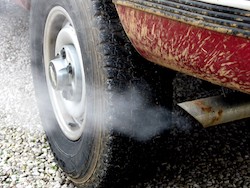SEJournal Online is the digital news magazine of the Society of Environmental Journalists. Learn more about SEJournal Online, including submission, subscription and advertising information.
TipSheet: Summertime and the Air is (Cough) Unhealthy
Smog season begins as summer heats up in many U.S. metropolitan areas, bringing journalists a new crop of air pollution stories.
 Smog’s main ingredient is ozone, formed by a chemical reaction in the air that comes mainly from things like nitrogen oxides and volatile organic compounds, typically found in car exhaust and industrial emissions. The reaction takes place in sunlight and is enhanced by hot summer weather.
Smog’s main ingredient is ozone, formed by a chemical reaction in the air that comes mainly from things like nitrogen oxides and volatile organic compounds, typically found in car exhaust and industrial emissions. The reaction takes place in sunlight and is enhanced by hot summer weather.
Ozone has serious health implications. Breathing it can cause chest pain and airway inflammation and can harm the lungs. It worsens bronchitis, emphysema and asthma.
But you don’t need to wait until authorities issue a health advisory to write about it. Just last week on June 6, 2017, U.S. Environmental Protection Agency Administrator Scott Pruitt made news when he delayed by a year the implementation of tighter ozone standards set under the Obama administration.
Obama in 2015 had lowered the health-based ozone standard to 70 parts per billion (down from the 75 ppb standard set under former President George W. Bush). Both industry and environmentalists complained.
The effects of that change will take years to kick in under the Clean Air Act, however, as urban airsheds are found to be in nonattainment and states and localities work out plans for reducing pollution. Under Pruitt, EPA has hinted that it may even reconsider Obama’s 70 ppb standard.
Find out local smog factors
This all takes on meaning in your area when temperatures rise, traffic stalls, the air gets brown, your eyes start stinging and you begin to cough.
 |
|
Chemicals found in auto exhaust react to create ozone, the main ingredient in smog. Hot summer weather enhances the reaction, worsening the problem. PHOTO: frankieleon, Flickr Creative Commons |
At times like this, you are likely to hear health advisories on TV telling people (especially the very old and very young) to stay indoors and avoid strenuous physical activity. The color-coded system is known as the Air Quality Index. Green is good, orange is worrisome and red is dangerous. Nowadays, many news media run the AQI daily beside the weather report.
You can see an impressive (and sometimes scary) animation of smog pollution as it develops daily on EPA’s AirNow website.
Are there special factors that make smog worse or better in your area? In greater Los Angeles, it is not just the freeway traffic but the basin where air is trapped by the mountains. In Houston it is the petrochemical industry and the heat.
Because smog problems are usually metropolitan-wide and multi-jurisdictional, there is often a special agency to deal with them. In L.A., for example, there is the South Coast Air Quality Management District.
In other areas, such as the District of Columbia, it may be a “council of governments” that deals with a host of metropolitan issues besides air pollution. Such airsheds not only cross municipal boundaries, but often state boundaries as well. Start by finding your own regional air quality management district or agency.
Is your area in ‘nonattainment’?
A lot can depend on whether an area meets the ozone standards. Officially, EPA designates areas as being in either attainment or nonattainment. In actuality, states, tribes and pollution data also have a lot to do with it.
When the health-based ozone standard changes, as it did in 2015, EPA has two years to come up with new attainment designations, and the agency had expected to do so by October 2017. It is this deadline that EPA’s Pruitt just this month extended by a year.
Even though the most recent designations may be obsolete or moot, you may want to see where the problems have been chronically in the past. Things do not improve that much that often. Not surprisingly, the worst areas historically have been concentrated in California, Houston and the industrialized Atlantic Northeast.
EPA’s “Green Book” showing Clean Air Act nonattainment areas is available online and in map form. The American Lung Association offers an even more helpful online way to look at the same data (especially historical trends), with its annual searchable, zip-code-based “State of the Air” report.
* From the weekly news magazine SEJournal Online, Vol. 2, No. 24. Content from each new issue of SEJournal Online is available to the public via the SEJournal Online main page. Subscribe to the e-newsletter here. And see past issues of the SEJournal archived here.













 Advertisement
Advertisement 



